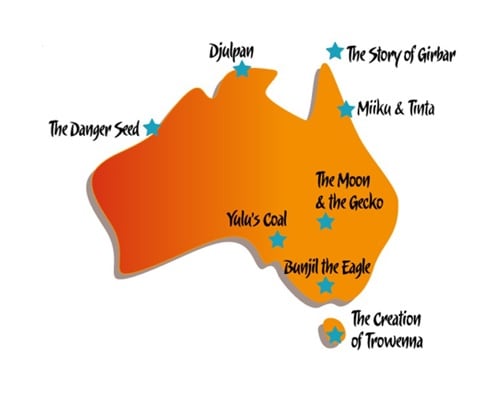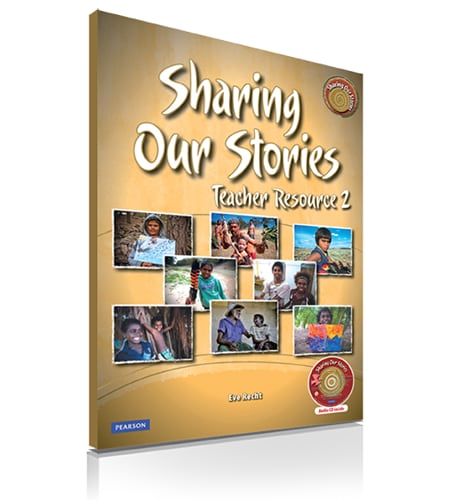This review was originally published in volume 44, #2, 2021 of Fine Print, the journal of the Adult Literacy and Basic Education Council (VALBEC). The author has been granted Pearson permission to reproduce this review on this website.
Sharing Our Stories: series produced by Pearson and SharingStories Foundation
Reviewed by Deryn Mansell for Fine Print.
Sharing Our Stories comprises two series of books designed to bring Aboriginal and Torres Strait Islander histories and cultures to the classroom.
There are six books in Series 1 and eight in Series 2. Each book focuses on one Indigenous Australian community and is centred on a story that is significant to that community. Storytellers, children and elders from the community speak directly to the reader. They introduce their community, explain their choice of story and its importance to the community, then talk about what the story means to them.
Photographs of community members and significant places accompany the text and the children’s artwork illustrates the stories. Together with the conversational text, the images draw the reader in and reinforce the sense that these are present day stories, even as they are thousands of years old. Complex or unfamiliar words and concepts are written in bold type and explained in a glossary that runs along the bottom of the page. At the end of most of the books, the story is told in its original Indigenous language.
All the text is presented as quoted speech in the voices of adults and children in the featured community. This stylistic decision gives authority to voices that are not usually privileged in educational texts. So, apart from being an authentic source of information, the books may encourage adult learners to recognise their own wisdom and authority. Also, the authenticity of the language means that, while packaged as a resource for primary school classrooms, the series could easily be used in adult learning settings without any sense that the learners are reading juvenile literature.
When introducing their story, many of the storytellers begin by saying something like, “This is a story told to me by my grandmother.” As well as giving the reader insight into the oral traditions of Aboriginal and Torres Strait Islander communities, such statements open the way to discuss the oral traditions at the heart of every culture – another opportunity to consider wisdom and authority from a different perspective.
|
The first series of Sharing Our Stories, published in 2008, featured stories from communities in Western Australia and Northern Territory, while the second series, published in 2011, expanded the sources to also include communities from Victoria, Tasmania, South Australia, New South Wales and Queensland as well as Saibai Island, located less than five kilometres from Papua New Guinea in the Torres Strait. The inclusion of stories from the Jaara community in central-western Victoria (Bunjil the Eagle) and the Neonone people of Bruny Island in Tasmania (The Creation of Trowenna) is welcome. It is often difficult to find resources that represent Aboriginal communities in the southern states as living cultures. There is a lot to learn – for teachers as well as students – from all of the books in Sharing Our Stories. |
 |
For each series there is a Teacher Resource book written by Eve Recht. This contains a synopsis of each story, maps and information about the communities, learning outcomes, suggested activities, black line masters and an interview with Liz Thompson, the photographer, writer, radio producer and documentary filmmaker who collaborated with the communities to create the books. The Resource also includes an audio CD featuring community members telling the story in English or its original language as well as environmental and everyday sounds from the community. The learning outcomes and black line masters are more relevant for primary school teachers than other educators but the suggested activities for each title offer some great ideas that would be readily adaptable to an adult setting. The story synopses, maps and community information give an excellent overview of the content of the books in the series, so teachers can use this to decide which titles in the series to seek out.
|
The interview with Liz Thompson in Teacher Resource 2 offers insights into the making of the series and the principles behind it. When asked why Sharing Our Stories is an important project, Thompson replies in part: We are losing the old people who carry the stories and songs. Many young people no longer speak the languages that the song cycles are sung in. As Alistair Djalolba James said in Turtle Dreaming, “That old man Jimmy (Bungurru), he knows the story, but it’s like some of the pages are missing. So already we’ve lost some, now we’re trying to hold on to the rest.”1 While this reminds us of the importance of recording the stories before they are lost, the books themselves are not weighed down by a sense of loss – the inclusion of children’s voices and artworks give the stories vibrance and hope. |
 |
Short films from the eight communities featured in Sharing Our Stories Series 2 are also available on the Pearson website, and a range of resources related to the series are available on the SharingStories Foundation website.
Sharing Our Stories was the overall winner of the Educational Publishing Awards Australia in 2009 and Liz Thompson was awarded the Judges Award for Innovator in the 2021 Pro Bono Impact Awards.
Books from Sharing Our Stories are published by Pearson.
Notes
1 Quoted on p. 9 of Sharing Our Stories: Teacher Resource 2
You might also be interested in
Resource for educators looking to incorporate Aboriginal and Torres Strait Islander histories and cultures into the classroom



